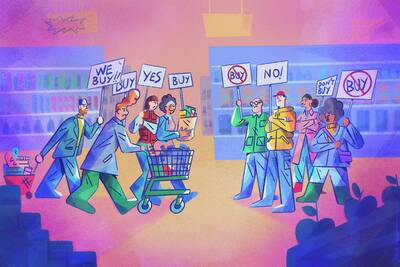When James Wilkie, a PhD student at the Kellogg School of Management, began thinking about the subtle effects that the shape of objects can have on human behavior, he had no idea it would lead to research that would suggest that men survey and edit their preferences for everyday objects in order to avoid the high costs of gender nonconformity.
What’s more, Wilkie found, the effort men require to constantly masculinize their preferences for everything from food to shower heads can take a toll on their ability to perform other cognitively demanding tasks.
There is a sprawling literature arguing that men feel more pressure than women to conform to gender norms, which Wilkie and his advisor, David Gal, an assistant professor of marketing at the Kellogg School, discovered only after they had conducted initial research on how creating conditions of cognitive scarcity affect the choices of men and women.
“I think what surprised us initially was how pervasive gender associations were with everyday items, such as with ordinary food items and household items like door handles and sinks that were shaped in particular ways. Also, we were surprised by the subtlety of manipulations that could influence gender associations. For instance, giving foods a more sophisticated sounding name tended to make people perceive the foods as more feminine,” Gal says.
Wilkie and Gal found that, unlike men, women do not appear to preferentially make “feminine” choices when presented with lists of objects with feminine and masculine associations, and as a consequence they do not suffer deficits in processing ability when forced to choose between the two.
“If we had found that women behaved the same as men—that is, they made more feminine choices—we wouldn’t have pursued this or published it because that wouldn’t have been as interesting as what we found,” Wilkie says.
The Thinking Man’s Choice
The two researchers teased out these phenomena with a series of four experiments. In the first experiment, men and women were presented with a list of menu items that, it was previously established, sounded either masculine of feminine. Then half the men and half the women were given either all the time they needed to choose the items they would like from the list or too little time, thus simulating conditions of either high or low availability of mental processing resources.
Men with too little time made food choices in the same manner as women—that is, they chose equally from a randomized list both “feminine” and “masculine” items. Men with ample time to mull their choices, however, were more likely to choose the masculine items, but not so women in the same situation.
“Men are really sensitive about appearing like they’re making gender-appropriate choices, whereas women don’t appear to care at all.”
“There’s literature showing that when people have time or can concentrate on things, they tend to incorporate norms or expectations or things like that into their decisions,” Wilkie says.
The second experiment proceeded in the same way as the first, but instead of a paucity of time, Wilkie and Gal used distractions to create conditions of low mental processing resources. They also had men and women choose from a pictorial list of everyday objects, from doorknobs and mirrors to showerheads and coffee tables. Previous work by other researchers had established that people in western cultures perceive objects with angles as more masculine and rounded objects as more feminine.
The results were the same: without enough mental resources to make the “right”—gender-normative—choice, men chose equally from among the feminine and masculine objects, just like women, but given more time, they tended to select the masculine objects. “The shapes experiment showed that you can have these subtle associations with any kind of item, and they affect your choices without your really realizing it,” Wilkie says.
In Wilkie and Gal’s third and fourth experiments, they reversed the chain of cause and effect in order to show that the effort required to make gendered choices degrades men’s performances on other cognitively demanding tasks.
For example, in their third experiment, Wilkie and Gal had men and women choose from lists that included either only objects associated with their gender or a mix of masculine and feminine objects. Men, but not women, forced to choose between objects of both genders subsequently performed worse on a test of their abilities—an anagram task.
Similarly, in the last experiment, men who had to engage in a task that threatened their masculinity—listing things they talked about with female but not male friends—were subsequently more likely to make gender-congruent food choices, but only when they had enough cognitive resources available.
The profound differences between men and women uncovered in these experiments were “initially not what we expected,” Wilkie says. “When we found that women weren’t changing choices at all and men were, that made us want to explore more,” he adds.
Marketing to Men
The research has a number of implications, among them that how food should be marketed to men depends on the goals of the party doing the advertising.
“In terms of marketing implications, our findings suggest that products or brands that are targeted to both men and women might want to err on the side of adopting a masculine rather than feminine positioning, since men are more likely to be influenced by product and brand gender associations,” Gal says. “For example, Coca-Cola realized that Diet Coke, by having the word ‘Diet’ in the name, was perceived as feminine, so it introduced Coke Zero specifically as a no-calorie drink with a masculine identity.”
Anyone attempting to get men to eat healthier should also keep this research in mind. “It isn’t always the case that men have to eat steak all the time—they can eat healthy and might be more apt to eat in that manner if healthy food is described in a more masculine manner,” Wilkie says. For example, in their experiments, Wilkie and Gal referred to “chunks” instead of “bits” of fruit to denote masculinity in yogurt.
The deeper meaning of this work derives from its confirmation of a larger literature on the gender-normative pressures that men feel but rarely discuss. The stereotype in western cultures—Wilkie expects his results would have been different had he conducted his experiments on subjects other than Americans—is that men are insensitive and don’t care about what people think about them, whereas women do, Wilkie says.
“This is an instance where the exact opposite is the case,” Wilkie says. “Men are really sensitive about appearing like they’re making gender-appropriate choices, whereas women don’t appear to care at all.”
Related reading on Kellogg Insight:
The Biochemistry of Financial Risk: Testosterone’s influence on financial decisions
Gal, David, and James Wilkie. 2010. Real Men Don’t Eat Quiche: Regulation of Gender-Expressive Choices in Men. Social Psychological and Personality Science, October, 1(4): 291-301.


